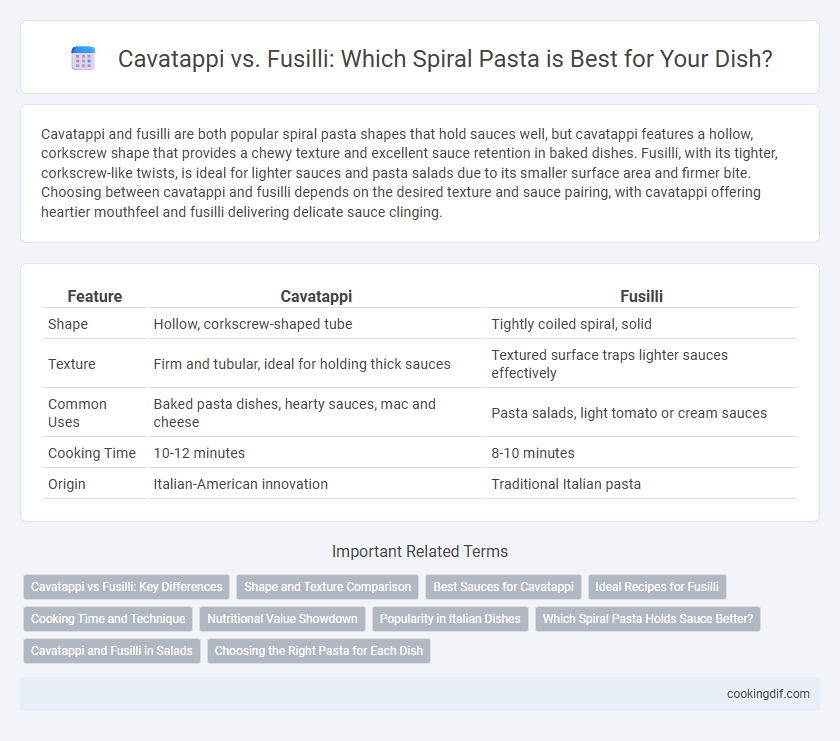Cavatappi and fusilli are both popular spiral pasta shapes that hold sauces well, but cavatappi features a hollow, corkscrew shape that provides a chewy texture and excellent sauce retention in baked dishes. Fusilli, with its tighter, corkscrew-like twists, is ideal for lighter sauces and pasta salads due to its smaller surface area and firmer bite. Choosing between cavatappi and fusilli depends on the desired texture and sauce pairing, with cavatappi offering heartier mouthfeel and fusilli delivering delicate sauce clinging.
Table of Comparison
| Feature | Cavatappi | Fusilli |
|---|---|---|
| Shape | Hollow, corkscrew-shaped tube | Tightly coiled spiral, solid |
| Texture | Firm and tubular, ideal for holding thick sauces | Textured surface traps lighter sauces effectively |
| Common Uses | Baked pasta dishes, hearty sauces, mac and cheese | Pasta salads, light tomato or cream sauces |
| Cooking Time | 10-12 minutes | 8-10 minutes |
| Origin | Italian-American innovation | Traditional Italian pasta |
Cavatappi vs Fusilli: Key Differences
Cavatappi and fusilli are both popular spiral pasta shapes but differ in structure and texture, with cavatappi being a corkscrew-shaped tube and fusilli featuring tight, flat spirals. Cavatappi's hollow center allows it to hold thick sauces and cheese more effectively, making it ideal for baked dishes and creamy sauces. Fusilli's tighter spirals trap lighter sauces and dressings, providing a more pronounced flavor coating suitable for pasta salads and lighter recipes.
Shape and Texture Comparison
Cavatappi features a hollow, corkscrew shape with a ridged surface, offering a firm texture that holds thicker sauces effectively. Fusilli has a tighter, spiral form with grooves that trap lighter sauces, providing a slightly softer bite in comparison. Both pasta types excel at clinging to dressings, but cavatappi's larger tubes create more chew and structural integrity.
Best Sauces for Cavatappi
Cavatappi's hollow, corkscrew shape makes it ideal for thick and creamy sauces like Alfredo, cheese-based sauces, and rich tomato sauces, as the grooves trap the sauce effectively. Fusilli, while also spiral-shaped, works better with lighter, oil-based dressings or pesto, as its tighter spirals hold less sauce. For hearty dishes, cavatappi pairs perfectly with meat ragu or baked pasta recipes due to its robust texture and sauce-holding capabilities.
Ideal Recipes for Fusilli
Fusilli's tight, corkscrew shape excels at holding chunky sauces, making it perfect for robust tomato or pesto dishes where sauce adherence is key. Its slightly firmer texture pairs well with baked pasta recipes and pasta salads, providing a satisfying bite. Ideal recipes for fusilli include creamy mushroom pasta, Mediterranean vegetable pasta, and classic marinara with meatballs.
Cooking Time and Technique
Cavatappi pasta typically requires 9 to 12 minutes of boiling, offering a slightly firmer texture compared to fusilli, which cooks faster in about 7 to 10 minutes due to its thinner spirals. The corkscrew shape of cavatappi allows it to hold thicker sauces and provides a chewier bite, while fusilli's tight twists are ideal for lighter dressings and quicker cooking techniques like sauteing. Understanding these differences helps optimize cooking time and enhances the pasta's ability to complement various recipes.
Nutritional Value Showdown
Cavatappi and fusilli both offer unique nutritional profiles, with cavatappi typically higher in calories and carbohydrates due to its denser texture, making it a heartier option for energy needs. Fusilli often contains slightly fewer calories and carbohydrates, with a marginally higher protein content, benefiting those aiming for balanced macronutrients. Both spiraled pastas provide essential nutrients like fiber and B vitamins, but choice depends on dietary goals such as calorie control or muscle maintenance.
Popularity in Italian Dishes
Cavatappi and fusilli are both popular spiral pasta shapes frequently used in Italian dishes, with fusilli being more traditional and widely recognized in authentic regional recipes. Fusilli's tight spiral shape holds sauces exceptionally well, making it a favorite for pesto and tomato-based dishes, while cavatappi, with its corkscrew form, is often favored in baked pasta dishes and creamy sauces. In terms of popularity, fusilli tends to dominate in classic Italian cuisine, whereas cavatappi is more commonly used in American-Italian adaptations.
Which Spiral Pasta Holds Sauce Better?
Cavatappi's hollow, ridged tubes provide more surface area and an interior space that traps thicker sauces effectively, making it ideal for creamy or chunky pasta dishes. Fusilli's tight spirals excel at holding lighter sauces and dressings by clinging to the pasta's helical grooves, enhancing flavor distribution in cold or oil-based preparations. When choosing spiral pasta for sauce retention, cavatappi outperforms fusilli for robust, hearty sauces, while fusilli works best with lighter, less viscous sauces.
Cavatappi and Fusilli in Salads
Cavatappi and fusilli are popular spiral pasta shapes often used in salads for their texture and ability to hold dressings. Cavatappi's hollow, corkscrew shape captures creamy or chunky dressings effectively, making it ideal for robust, hearty salads. Fusilli's tighter spirals provide a denser bite and are perfect for lighter, vegetable-rich salads, offering a contrast in texture and enhancing flavor distribution.
Choosing the Right Pasta for Each Dish
Choosing between cavatappi and fusilli depends on the dish's texture and sauce requirements; cavatappi's hollow, ridged spiral shape holds thick, creamy sauces well, making it ideal for mac and cheese or baked casseroles. Fusilli features tighter, corkscrew-like spirals that trap lighter, oil-based sauces and chunky vegetable or meat bits, perfect for pasta salads and lighter dishes. Understanding these textural and sauce-holding differences helps optimize flavor and mouthfeel in each recipe.
Cavatappi vs fusilli for spiral pasta Infographic

 cookingdif.com
cookingdif.com